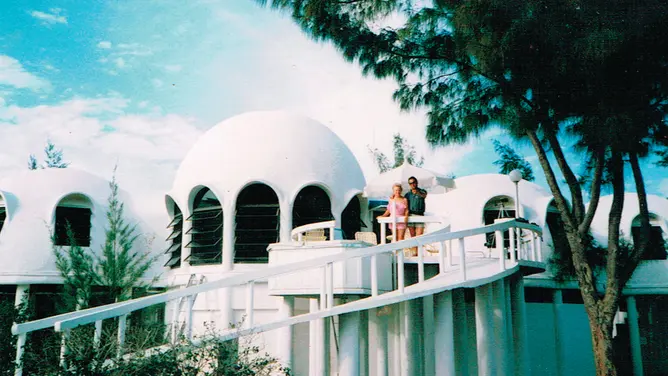The Cape Romano Dome House is one of Florida’s most intriguing architectural curiosities. Located off the coast of Marco Island in Southwest Florida, this cluster of dome-shaped structures has captured the imagination of locals, tourists, and historians alike. From its innovative design to its mysterious abandonment and eventual submersion into the Gulf of Mexico, the Dome House has a fascinating history. This guide delves into the origins, construction, and eventual fate of this iconic landmark.
1. The Vision Behind the Dome House
The Cape Romano Dome House was the brainchild of Bob Lee, a retired oil producer from Tennessee. In the early 1980s, Lee sought to create a self-sustaining, eco-friendly home that could withstand the harsh weather conditions common to coastal Florida. Inspired by the geodesic dome designs of architect Buckminster Fuller, Lee envisioned a structure that was both energy-efficient and resilient.
Key Features of the Design
- Dome Shape: The six interconnected domes were designed to withstand high winds and hurricanes, making them ideal for the Florida coast.
- Solar Power: The house was equipped with solar panels, making it one of the first solar-powered homes in the region.
- Rainwater Collection: A system was installed to collect and filter rainwater for household use.
- Insulation: The thick concrete walls provided excellent insulation, keeping the interior cool in the summer and warm in the winter.
2. Construction of the Dome House
Construction of the Dome House began in 1980 and was completed in 1982. The project was a massive undertaking, requiring innovative engineering and construction techniques.
Building Materials
- The domes were constructed using concrete and reinforced steel, ensuring durability and strength.
- The exterior was coated with a waterproof sealant to protect against saltwater corrosion.
Challenges
- Building on a remote barrier island presented logistical challenges, including transporting materials and equipment to the site.
- The construction team had to work around the tides and weather conditions, which often delayed progress.
Despite these challenges, the Dome House was completed and became a functional, futuristic home that attracted attention for its unique design and sustainable features.
3. Life at the Dome House
For several years, the Dome House served as a vacation home for Bob Lee and his family. The house was equipped with modern amenities, including a fully functional kitchen, bathrooms, and bedrooms. The solar panels provided enough energy to power the home, and the rainwater collection system ensured a steady supply of fresh water.
A Unique Living Experience
- The Dome House offered stunning views of the Gulf of Mexico and the surrounding natural beauty.
- Its remote location provided a sense of privacy and tranquility, making it an ideal retreat.
However, the Lee family eventually sold the property, and the Dome House changed hands several times over the years.
4. The Decline of the Dome House
The Dome House’s fortunes began to decline in the 1990s due to a combination of natural and human factors.
Erosion and Rising Sea Levels
- Coastal erosion gradually ate away at the island, bringing the Gulf of Mexico closer to the Dome House.
- Rising sea levels, exacerbated by climate change, further accelerated the erosion process.
Hurricanes and Storms
- The Dome House was designed to withstand hurricanes, but repeated storms took their toll on the structure.
- Hurricane Wilma in 2005 caused significant damage, leaving the domes partially submerged.
Abandonment
- By the early 2000s, the Dome House was no longer habitable. The rising waters and frequent storms made it impractical to maintain or repair the structure.
- The property was eventually abandoned, and the domes became a haunting reminder of the power of nature.
5. The Dome House as a Local Landmark
Despite its abandonment, the Cape Romano Dome House became a popular attraction for boaters, kayakers, and photographers. Its otherworldly appearance and mysterious history drew visitors from near and far.
Cultural Significance
- The Dome House has been featured in numerous articles, documentaries, and social media posts, cementing its status as a local legend.
- It has also inspired artists and writers, who see it as a symbol of human ingenuity and the forces of nature.
Environmental Impact
- The submerged domes have become an artificial reef, attracting marine life and providing a unique ecosystem for fish and other sea creatures.
- However, concerns have been raised about the potential environmental hazards posed by the deteriorating structure.
6. The Future of the Dome House
The fate of the Cape Romano Dome House remains uncertain. While some advocate for its preservation as a historical and ecological site, others argue that it poses a risk to the environment and should be removed.
Preservation Efforts
- Some locals and historians have called for the Dome House to be protected as a cultural landmark.
- Efforts have been made to document its history and raise awareness about its significance.
Removal Plans
- In recent years, there have been discussions about dismantling the domes to prevent them from becoming a hazard to navigation or the environment.
- The cost and logistics of removing the structure, however, present significant challenges.
7. Visiting the Dome House
For those interested in seeing the Dome House up close, it remains accessible by boat or kayak. However, visitors should exercise caution, as the structure is unstable and the surrounding waters can be unpredictable.
Tips for Visitors
- Check the weather and tide conditions before planning your trip.
- Respect the site and avoid climbing on the domes, as they are fragile and potentially dangerous.
- Take only photos and leave only footprints to help preserve the area.
Conclusion
The Cape Romano Dome House is a testament to human creativity and the relentless power of nature. From its innovative design and sustainable features to its eventual decline and transformation into an underwater landmark, the Dome House has a rich and fascinating history. Whether it remains a submerged relic or is eventually removed, its legacy will continue to captivate and inspire those who encounter it. For now, it stands as a poignant reminder of the delicate balance between human ambition and the natural world.




